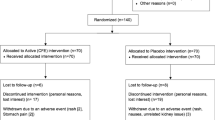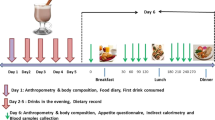Abstract
Objective:
To determine the safety and efficacy of a dietary supplement with a low dose of ephedra and caffeine in overweight/obese premenopausal female subjects.
Design:
A 9-month, double-blind, randomized control study compared the efficacy and safety of a dietary supplement with ephedra and caffeine to a control supplement.
Subjects:
Sixty-one healthy, premenopausal women with body mass index (BMI) from 27 to 39 kg/m2 were randomly assigned and received a dietary supplement (40 mg/day ephedra alkaloids, 100 mg/day caffeine, high potency mixture of vitamins, minerals, omega-3 fatty acids) or a control supplement for 9 months.
Measurements:
Efficacy: changes in body weight, body composition, lipids, insulin, leptin, adiponectin, ghrelin, and self-reports of physical activity, diet and quality of life indices. Safety: blood pressure, heart rate, electrocardiograms, urinalysis, blood histology, serum chemistry measures and self-reported symptoms.
Results:
Forty-one women completed the study. The treatment group lost significantly more body weight (−7.18 kg) and body fat (−5.33 kg) than the control group (−2.25 and −0.99 kg, respectively), and showed significant declines in heart rate, serum cholesterol, triglycerides, cholesterol to high-density lipoprotein ratio, glucose, fasting insulin, and leptin. Blood pressure, electrocardiograms, other clinical chemistry measures, blood histology, urinalysis, and self-reported physical activity were similar in the groups. Minor symptoms included dry mouth, insomnia, nervousness and palpitations. The treatment group reported more energy and decreased appetite compared to controls and scored higher on a quality of life domain assessing vitality.
Conclusion:
A dietary supplement containing a low potency ephedra/caffeine mixture appeared safe and effective in causing loss of weight and body fat, and improving several metabolic parameters, including insulin sensitivity and lipid profiles when tested under physician supervision. Such supplements could be a useful tool to assist with weight loss.
This is a preview of subscription content, access via your institution
Access options
Subscribe to this journal
Receive 12 print issues and online access
$259.00 per year
only $21.58 per issue
Buy this article
- Purchase on Springer Link
- Instant access to full article PDF
Prices may be subject to local taxes which are calculated during checkout


Similar content being viewed by others
References
Flegal KM, Carroll MD, Ogden CL, Johnson CL . Prevalence and trends in obesity among US adults, 1999–2000. JAMA 2002; 288: 1723–1727.
Flegal KM, Carroll MD, Kuczmarski RJ, Johnson CL . Overweight and obesity in the United States: prevalence and trends, 1960–1994. Int J Obes Relat Metab Disord 1998; 22: 39–47.
Finkelstein EA, Fiebelkorn IC, Wang G . State-level estimates of annual medical expenditures attributable to obesity. Obes Res 2004; 12: 18–24.
Stafford RS, Farhat JH, Misra B, Schoenfeld DA . National patterns of physician activities related to obesity management. Arch Fam Med 2000; 9: 631–638.
Wadden TA, Anderson DA, Foster GD, Bennett A, Steinberg C, Sarwer DB . Obese women's perceptions of their physicians' weight management attitudes and practices. Arch Fam Med 2000; 9: 854–860.
Astrup A, Breum L, Toubro S, Hein P, Quaade F . The effect and safety of an ephedrine/caffeine compound compared to ephedrine, caffeine and placebo in obese subjects on an energy restricted diet. A double blind trial. Int J Obes Relat Metab Disord 1992; 16: 269–277.
Boozer CN, Nasser JA, Heymsfield SB, Wang V, Chen G, Solomon JL . An herbal supplement containing Ma Huang-Guarana for weight loss: a randomized, double-blind trial. Int J Obes Relat Metab Disord 2001; 25: 316–324.
Boozer CN, Daly PA, Homel P, Solomon JL, Blanchard D, Nasser JA et al. Herbal ephedra/caffeine for weight loss: a 6-month randomized safety and efficacy trial. Int J Obes Relat Metab Disord 2002; 26: 593–604.
Department of Health and Human Services, Food and Drug Administration. Final rule declaring dietary supplements containing ephedrine alkaloids adulterated because they present an unreasonable risk. Available at: http://www.fda.gov/OHRMS/DOCKETS/98fr/1995n-0304-nfr0001.pdf. Accessed April 12, 2004.
Dallal G . Randomization. http://www.randomization.com/ [website]. July 27, 2003. Available at http://www.randomization.com/. Accessed November 18, 2002.
Van Loan MD WP, Matthie J, Mayclin PL . Use of bio-impedance spectroscopy (BIS) to determine extracellular fluid (ECF), intracellular fluid (ICF), total body water (TBW), and fat free mass (FFM). In: Ellis KJ, Eastman JD (eds). Human Body Composition. Plenum Press: New York, 1993. pp 67–70.
Perloff D, Grim C, Flack J, Frolich ED, Hill M, McDonald M, Morgenstern BZ . Human blood pressure determination by sphygmomanometry. Circulation 1993; 88: 2460–2470.
Joint National Committee on prevention, detection, evaluation, and treatment of high blood pressure. The sixth report of the Joint National Committee on prevention, detection, evaluation, and treatment of high blood pressure. Arch Intern Med 1997; 157: 2413–2446.
Lee HC, Curry DL, Stern JS . Tonic sympathetic nervous system inhibition of insulin secretion is diminished in obese Zucker rats. Obesity Res 1993; 1: 371–376.
Matthews DR, Hosker JP, Rudenski AS, Naylor BA, Treacher DF, Turner RC . Homeostasis model assessment: insulin resistance and beta-cell function from fasting plasma glucose and insulin concentrations in man. Diabetologia 1985; 28: 412–419.
United Stated Department of Health and Human Services. Coding Symbol and Thesaurus for Adverse Event Terminology (COSTART). US Department of Health and Human Services: Rockville, MD, 1990.
Block G, Woods M, Potosky A, Clifford C . Validation of a self-administered diet history questionnaire using multiple diet records. J Clin Epidemiol 1990; 43: 1327–1335.
Blair SN, Haskell WL, Ho P, Paffenbarger RS, Vranizan KM, Farquhar JW et al. Assessment of habitual physical activity by a seven-day recall in a community survey and controlled experiments. Am J Epidemiol 1985; 122: 794–804.
Ware Jr JE, Sherbourne CD . The MOS 36-item short-form health survey (SF-36). I. Conceptual framework and item selection. Med Care 1992; 30: 473–483.
Neter J, Kutner MH, Nachstheim CJ, Wasserman W . Applied Linear Statistical Models 4th edn. Chicago: Irwin, 1995.
Unnebrink K, Windeler J . Intention-to-treat: methods for dealing with missing values in clinical trials of progressively deteriorating diseases. Stat Med 2001; 20: 3931–3946.
Gadbury GL, Coffey CS, Allison DB . Modern statistical methods for handling missing repeated measurements in obesity trial data: beyond LOCF. Obes Rev 2003; 4: 175–184.
SAS Institute I. The SAS System for Windows, Version 9.1. SAS Institute: Cary, NC, 2003.
Bland JM, Altman DG . Transformations, means and confidence intervals. BMJ 1996; 312: 1079.
Haller CA, Benowitz NL . Adverse cardiovascular and central nervous system events associated with dietary supplements containing ephedra alkaloids. N Engl J Med 2000; 343: 1833–1838.
Shekelle PG, Hardy ML, Morton SC, Maglione M, Mojica WA, Suttorp MJ et al. Efficacy and safety of ephedra and ephedrine for weight loss and athletic performance: a meta-analysis. JAMA 2003; 289: 1537–1545.
McBride BF, Karapanos AK, Krudysz A, Kluger J, Coleman CI, White CM . Electrocardiographic and hemodynamic effects of a multicomponent dietary supplement containing ephedra and caffeine: a randomized controlled trial. JAMA 2004; 291: 216–221.
Haller CA, Jacob P, Benowitz NL . Pharmacology of ephedra alkaloids and caffeine after single-dose dietary supplement use. Clin Pharmacol Ther 2002; 71: 421–432.
Greenway FL, de Jonge L, Blanchard D, Frisard M, Smith SR . Effect of a dietary herbal supplement containing caffeine and ephedra on weight, metabolic rate, and body composition. Obes Res 2004; 12: 1152–1157.
Coffey CS, Steiner D, Baker BA, Allison DB . A randomized double-blind placebo-controlled clinical trial of a product containing ephedrine, caffeine, and other ingredients from herbal sources for treatment of overweight and obesity in the absence of lifestyle treatment. Int J Obes Relat Metab Disord 2004; 28: 1411–1419.
Fairfield KM, Fletcher RH . Vitamins for chronic disease prevention in adults: scientific review. JAMA 2002; 287: 3116–3126.
Singh RB, Beegom R, Rastogi SS, Gaoli Z, Shoumin Z . Association of low plasma concentrations of antioxidant vitamins, magnesium and zinc with high body fat per cent measured by bioelectrical impedance analysis in Indian men. Magnesium Res 1998; 11: 3–10.
Chen MD, Song YM, Lin PY . Zinc may be a mediator of leptin production in humans. Life Sci. 2000; 66: 2143–2149.
Westerterp-Plantenga MS, Kovacs EM . The effect of (−)-hydroxycitrate on energy intake and satiety in overweight humans. Int J Obes Relat Metab Disord 2002; 26: 870–872.
Shara M, Ohia SE, Yasmin T, Zardetto-Smith A, Kincaid A, Bagchi M et al. Dose- and time-dependent effects of a novel (−)-hydroxycitric acid extract on body weight, hepatic and testicular lipid peroxidation, DNA fragmentation and histopathological data over a period of 90 days. Mol Cell Biochem 2003; 254: 339–346.
Dubuc GR, Phinney SD, Stern JS, Havel PJ . Changes of serum leptin and endocrine and metabolic parameters after 7 days of energy restriction in men and women. Metabolism 1998; 47: 429–434.
Keim NL, Stern JS, Havel PJ . Relation between circulating leptin concentrations and appetite during a prolonged, moderate energy deficit in women. Am J Clin Nutr 1998; 68: 794–801.
Rosenbaum M, Murphy EM, Heymsfield SB, Matthews DE, Leibel RL . Low dose leptin administration reverses effects of sustained weight-reduction on energy expenditure and circulating concentrations of thyroid hormones. J Clin Endocrinol Metab 2002; 87: 2391–2394.
Havel PJ . Update on adipocyte hormones: regulation of energy balance and carbohydrate/lipid metabolism. Diabetes 2004; 53: S143–S151.
Cummings DE, Weigle DS, Frayo RS, Breen PA, Ma MK, Dellinger EP et al. Plasma ghrelin levels after diet-induced weight loss or gastric bypass surgery. N Engl J Med 2002; 346: 1623–1630.
Faraj M, Havel PJ, Phelis S, Blank D, Sniderman AD, Cianflone K . Plasma acylation-stimulating protein, adiponectin, leptin, and ghrelin before and after weight loss induced by gastric bypass surgery in morbidly obese subjects. J Clin Endocrinol Metab 2003; 88: 1594–1602.
Fine JT, Colditz GA, Coakley EH, Moseley G, Manson JE, Willett WC et al. A prospective study of weight change and health-related quality of life in women. JAMA 1999; 282: 2136–2142.
Daly PA, Krieger DR, Dulloo AG, Young JB, Landsberg L . Ephedrine, caffeine and aspirin: safety and efficacy for treatment of human obesity. Int J Obes Relat Metab Disord 1993; 17 (Suppl 1): S73–S78.
Dulloo AG . Ephedrine, xanthines and prostaglandin-inhibitors: actions and interactions in the stimulation of thermogenesis. Int J Obes Relat Metab Disord 1993; 17 (Suppl 1): S35–S40.
Haller CA, Jacob P, Benowitz NL . Short-term metabolic and hemodynamic effects of ephedra and guarana combinations. Clin Pharmacol Ther 2005; 77: 560–571.
Ray S, Phadke S, Patel C, Hackman RM, Stohs S . Short-term and long-term in vivo exposure to an ephedra- and caffeine-containing metabolic nutrition system does not induce cardiotoxicity in B6C3F1 mice. Arch Toxicol 2005; 79: 330–340.
Hutton B, Fergusson D . Changes in body weight and serum lipid profile in obese patients treated with orlistat in addition to a hypocaloric diet: a systematic review of randomized clinical trials. Am J Clin Nutr 2004; 80: 1461–1468.
Acknowledgements
We thank Kimberley Hansen BS for her clinical skills and Kimber Stanhope and James Graham for their technical assistance with the endocrine assays. The study was supported in part by an unrestricted gift from AdvoCare International, LP, Carrollton, TX.
Author information
Authors and Affiliations
Corresponding author
Rights and permissions
About this article
Cite this article
Hackman, R., Havel, P., Schwartz, H. et al. Multinutrient supplement containing ephedra and caffeine causes weight loss and improves metabolic risk factors in obese women: a randomized controlled trial. Int J Obes 30, 1545–1556 (2006). https://doi.org/10.1038/sj.ijo.0803283
Received:
Revised:
Accepted:
Published:
Issue Date:
DOI: https://doi.org/10.1038/sj.ijo.0803283
Keywords
This article is cited by
-
Efficacy of dietary supplements containing isolated organic compounds for weight loss: a systematic review and meta-analysis of randomised placebo-controlled trials
International Journal of Obesity (2021)
-
Coronavirus Disease 2019 and Herbal Therapy: Pertinent Issues Relating to Toxicity and Standardization of Phytopharmaceuticals
Revista Brasileira de Farmacognosia (2021)
-
Usage of Plant Food Supplements (PFS) for weight control in six European countries: results from the PlantLIBRA PFS Consumer Survey 2011-2012
BMC Complementary and Alternative Medicine (2016)
-
Acute effects of a commercially-available pre-workout supplement on markers of training: a double-blind study
Journal of the International Society of Sports Nutrition (2014)
-
Acute oral intake of a higenamine-based dietary supplement increases circulating free fatty acids and energy expenditure in human subjects
Lipids in Health and Disease (2013)



